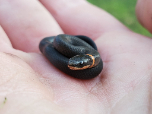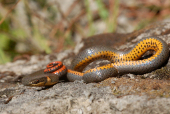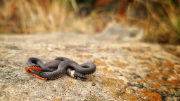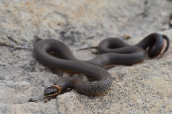Prairie Ringneck Snake (Diadophis punctatus arnyi)
Description: D. p. arnyi has a black-grey head, a grey body, and an orange ring around its neck. The ring does not extend toward the underside. The underside is yellow for a third of the body, orange for another third, and red for the last third. The belly also has black flecks along it. This snake has a blunt head, a tiny mouth, and small eyes. Anteriorly the dorsal scales are usually in 17 rows (other eastern subspecies have 15 rows). A mature prairie ringneck grows to about 9.8 to 14.2 inches in total length (including tail), record 16 1/2 inches.
Habitat: The prairie ringneck snake (as its name suggests) lives in or near prairies and can often be found sunbathing or slithering out in the open. It can also be found under old logs, rocks, pieces of wood and sheets of tin. It likes to live under dead leaves and foliage in the woods, and in grasses in the prairie.
Range: D. p. arnyi is very common within its range and can be found almost anywhere in Midwest North America, i.e., Iowa, Kansas, Missouri and northwestern Arkansas to South Dakota, Oklahoma and Texas.
Diet: D. p. arnyi eats insects, frogs, salamanders, other snakes, lizards, and newborn rodents. It uses a weak venom (not harmful to humans) in the saliva in its mouth to immobilize its prey. It also uses constriction.
Reproduction: From June to early August, adult females of D. p. arnyi lay 1 to 7 eggs (average 4). The eggs are on average 1.1 inches long by 1/4 inch wide. After being laid, the eggs increase in size until hatching. Hatching occurs after about 60 days. The hatchlings are around 3.9 inches in total length, and resemble adults except with a bluish cast dorsally.
Status: Listed as Least Concern in view of the very large and probably relatively stable extent of occurrence, area of occupancy, number of subpopulations, and population size. This species is not threatened in most of its range.
»» Kingdom: Animalia - Animals
»» Phylum: Chordata - Chordates
»» Subphylum: Vertebrata - Vertebrates
»» Class: Reptilia - Reptiles
»» Order: Squamata - Scaled Reptiles
»» Suborder: Serpentes
»» Superfamily: Colubroidea
»» Family: Colubridae - Colubrids
»» Genus: Diadophis
»» Species: Diadophis punctatus - Ringneck Snakes
»» Subspecies: Diadophis punctatus arnyi - Prairie Ringneck Snake
This article uses material from the Wikipedia article "Diadophis punctatus arnyi", which is released under the Creative Commons Attribution-Share-Alike License 3.0. Content may have been omitted from the original, but no content has been changed or extended.
|








